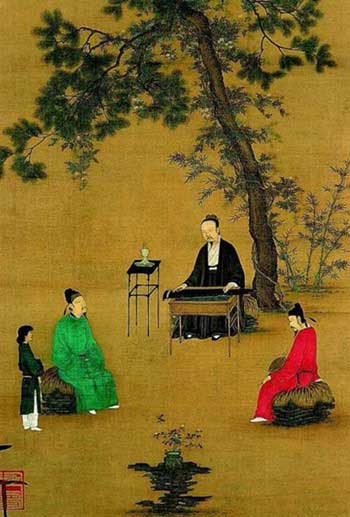- +86-13267351235
- info@globalstourtravels.com
Today, casual clothes are worn during non-working hours, in a non-working environment, on non-ceremonial occasions.
So what were casual clothes for ancient people, most of whom did not hold official positions? Ancient women did not go out to work, so there was no special provision for casual and non-casual clothes. Only empresses, imperial concubines, and entitled women had ceremonial dress. The texture, style and pattern of this dress was determined according to their husband's official rank, the clothes of male officials were strictly proscribed. There is an ancient Chinese saying which goes, "officials cannot help themselves," i.e. people who hold official positions receive official's salaries, so wherever they go, on whatever occasion, what carriages they drove, etc. should conform to a system of carriages and clothing. Wearing clothes of a lower level was beneath their dignity, and wearing clothes of a higher level was a capital crime, called "arrogation," which was, essentially, the crime of showing ambition.

A Song woman wearing short robes with straignt collars, buttons down the front adn narrow sleeves
There were casual clothes in all of the dynasties but in the history of China's clothes the most elegant, comfortable and characteristic of Chinese culture were the casual short robes of the Song Dynasty.
The commonest style of short robes during the Song Dynasty was the straight color style, with buttons down the front. The front had no buttons or loops, and the sleeves could be broad or narrow. Some of these robes covered the knees, some were knee-length, and some were ankle-length. Both sides of the robe were slit from the hem of the front to the waist, or from the armpit to the bottom. There were also styles without slits.
Short robes were liked by men and women of all ages and ranks, rich or poor. In the painting Yaotai Moon-viewing Platform, the woman wearing a short robe looks very quiet and elegant. Images of singing girls wearing short robes can be seen in mural paintings from the Song tomb of Baisha in Yu County, Henan. Maids wear short robes in the clay sculptures of Jinci Temple, Shanxi. All of these images tell us that women wore casual clothes on many different kinds of occasions, and this was deemed perfectly normal.
During the Song Dynasty, men wore short robes mostly when relaxing at home. The straight-waisted style of short robes of various widths and lengths with no buttons or loops was the most casual. In Tuning the Lute (or Listening to the Lute), said to be a self-portrait of Emperor Huizong of the Song Dynasty, Zhao Ji (1082-1135), the emperor wears a short robe made of dark materials. The Chinese emperor wore short robes when at home, due to their degree of comfort. In the Dunhuang murals, Vimalakirti, a famous character in Buddhist stories, can be seen. In Tang paintings, he wears the Tang round-collar gown, but in Song paintings, he wears a short robe instead. Of course, the clothes of religious figures can change over time and this mural shows us that short robes were most prevalent during the Song Dynasty.
Although there were no special requirements regarding the gender and status of people who wore short robes, most of the people who wore them were high-born or middle-class people; laborers usually wore short upper garments and short trousers. Short robes are closely associated with Song Dynasty culture - they had straight contours with no curves, and are clearly different from Tang clothes, which were characterized by open collars, broad skirts and fine gauze gowns with big sleeves. Tang clothing was magnificent and ostentatious, while Song clothing was restrained, with an ascetic tendency. This clothing psychology is closely related to the Song Dynasty's thinking on social hierarchy, which emphasized the subordination of the inferior classes to the superior classes. These beliefs were reflected in the relationship between the emperor and his ministers, between fathers and sons, and between husbands and wives. Human emotions were suppressed, and a deeper mental space was pursued via a process of internalization.

Truning the Lute (part) by Zhao Ji (Song Dynasty). The person playing the lute in the painting is Emperor Huizong of the Song Dynasty, Zhaoji. The emperor also wore the short robe when at home, which shows that such clothes were popular
Therefore, the Chinese classical aesthetic reached its peak during the Song Dynasty -architecture emphasized white walls and black tiles, pottery emphasized single-color glazes, painting emphasized impressionistic ink and wash landscape painting, and even an appreciation of flowers emphasized varieties symbolizing people's moral worth, such as the plum, orchid, bamboo and chrysanthemum. Short robes were elegant and straightforward but they were really masterpieces of simplicity that concealed complex ideas and beliefs.
After the Song Dynasty, in the Ming and Qing dynasties, the sleeveless overcoat received much attention. Ming women wore a long knee-length or ankle-length sleeveless overcoat called a "bijia overcoat." Some traditional Chinese clothes were beautiful but not comfortable, while others were comfortable but not beautiful, but the bijia overcoat was both comfortable and beautiful. The bijia featured embroidery, woven patterns, inlaid collar decorations, decorative jade plates, and the buttons down the middle were exquisite, delicate, and elegant. Images of women wearing bijia overcoats can be seen in many "belle" paintings of the Ming Dynasty. Ming women with slim figures were thought of as beautiful and the bijia overcoat accentuated a slender figure.
The main materials of Chinese traditional clothes are silk and cotton. They are very soft and can adapt to various different postures and demands for flexibility from different limbs. Stiff and neat shoulders, and rigid chest and back panels were not emphasized, meaning the body was not restrained. The short robe and bijia overcoat do not strict the waist and have no waistband, allowing maximum room for the body to move. These clothes are casual and comfortable when seen from a modern perspective, as well as an ancient one.